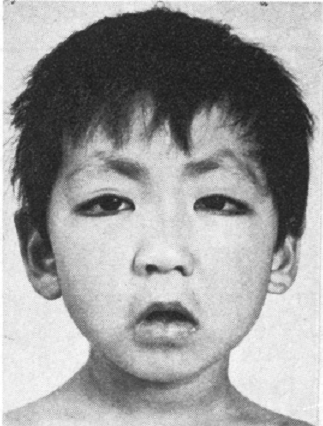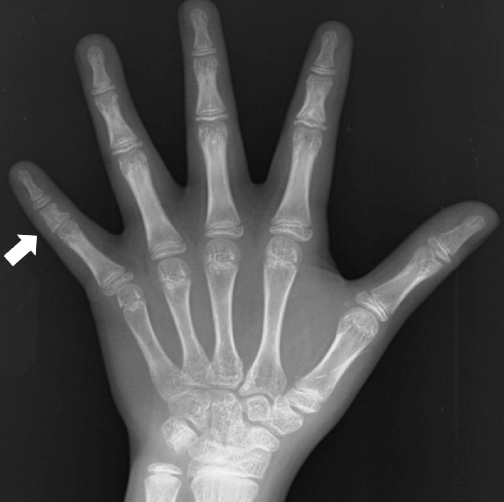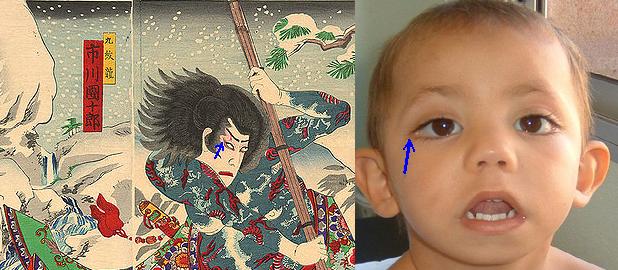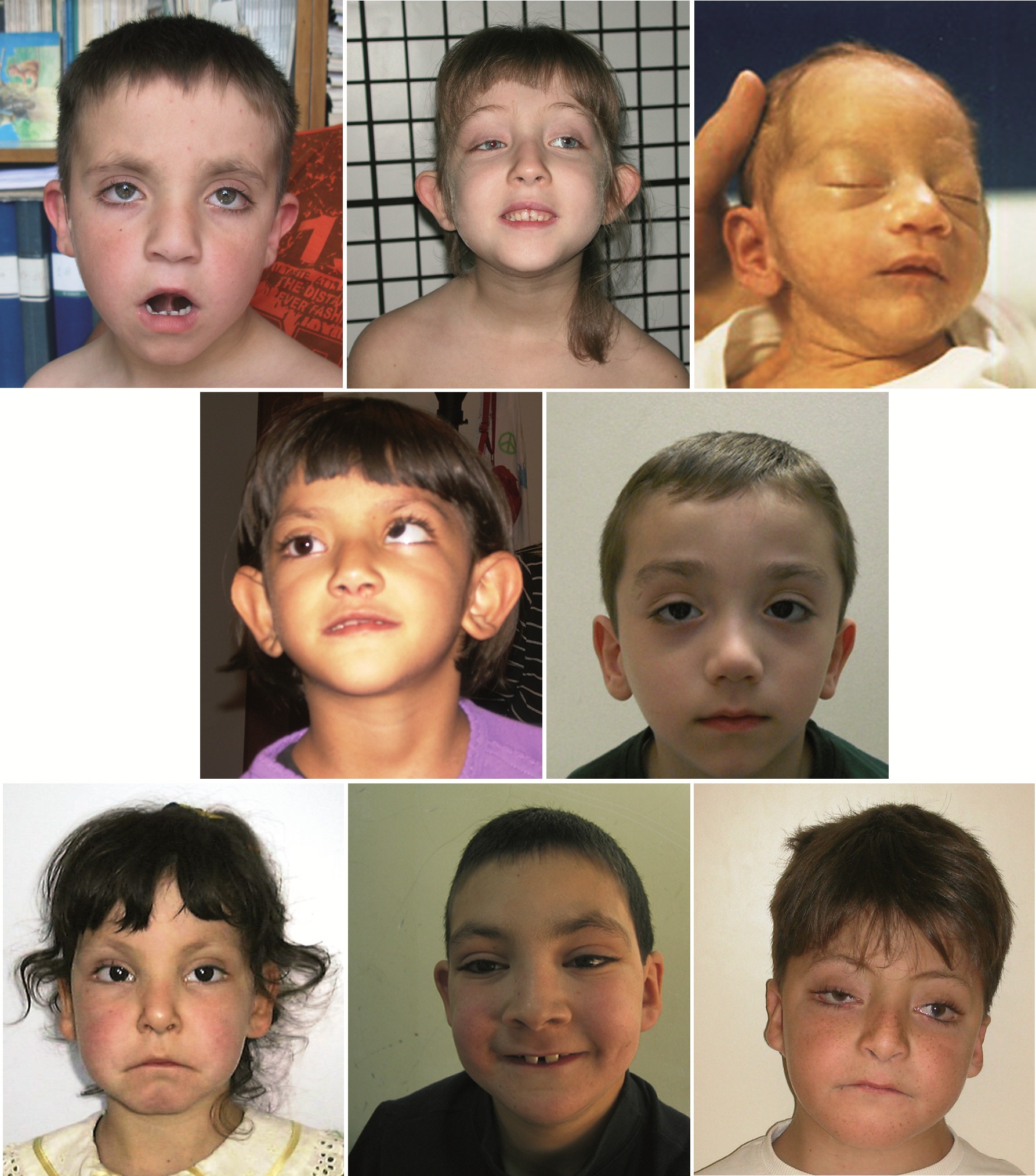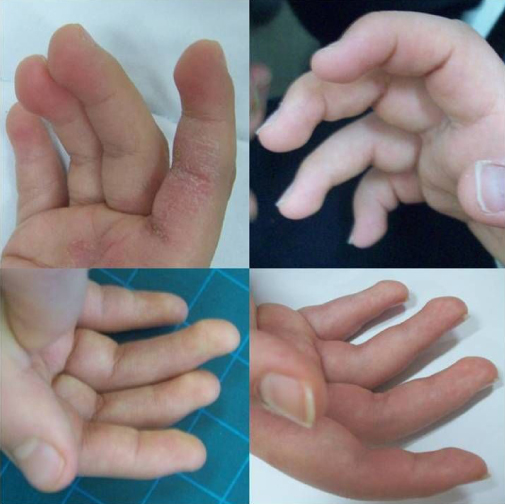Kabuki Syndrome (KS)
Kabuki syndrome, or KS, is a multisystem disorder that affects all races and ethnic groups. It was first described in 1981 in Japanese patients, and is also called Kabuki makeup syndrome (1, 2). The name derives from characteristic facial features that resemble actors playing in the Kabuki. The photo at top right and the woodcut below on the right illustrate this similarity.
Kabuki syndrome affects males and females. It also appears to affect all races and ethnic groups. Its prevalence in Japan has been estimated to be 1 person in 32,000 (3). NIH's GeneReviews article on KS states that this figure is likely to be true for populations outside Japan, and it also notes that prevalence in Australia and New Zealand is a minimum of 1 in 89,000 (4). Using the 1:32,000 figure would mean that there are roughly 4,000 KS patients in Japan, 10,000 in the United States, and 220,000 worldwide. Thus, while KS is a rare syndrome, it is not as rare as many others, such as those with US patient populations below 1,000.
Clinical information
People with Kabuki syndrome have distinctive facial features (see photos on this page). In particular, they have long palpebral fissures, or long eyes. They also tend to have many or most of the features listed below:
- Long palpebral fissures (openings that form eyes; see photos)
- Lower eyelid turned outward
- Large or prominent ears
- Highly arched eyebrows
- Tip of nose flattened
- Sparse eyebrow hair
- Very small jaw
- Widely-spaced teeth
- Droopy eyelids (ptosis)
- Blue sclera (whites of eyes)
- Strabismus (eyes not aligned)
Common facial features of Kabuki syndrome
These facial features are very helpful in forming an initial suspicion that a patient has Kabuki syndrome. However, KS affects many body systems. Other signs and symptoms include physical and neurological features as follows:
- Fetal finger pads (lumps on fingertips; see photos below)
- Short and/or bent pinky finger (see photo below)
- Microcephaly/small head
- Intellectual disability
- Hypotonia/floppiness
- Short stature
- Cardiac defects
- Loose/lax joints
- Dental abnormalities
- High-arched palate or cleft palate
Common clinical features of Kabuki syndrome
In our analysis of published case histories for our software tool, we found that the three most commonly occuring features of KS were long palpebral fissures (more than 99% of ~200 patients), eyelid ectropion (lower eyelids turned outward) in 89% of patients, and fingertip pads (also 89% of patients).
A large majority of people with Kabuki syndrome are mildly or moderately intellectually disabled, although a small number may be severely disabled. In fact, intellectual disability was the fourth most common clinical feature in our analysis. However, a minority of patients have IQs in the normal range. In our analysis of 250 patients in whom intellectual ability had been reported, 218 had intellectual disabilities, leaving 32 who did not (13%). This figure is in rough agreement with a 2003 study that found normal intelligence in 31/188 patients (16%; 5).
Although short stature is a common feature in people with KS, a large minority of patients are not short. For example, the review noted in the last paragraph found short stature in only 55% of 136 patients (5). Similarly, our analysis of 256 patients in whom height was reported found that 61% were short. Thus, is it important not to exclude KS in a patient who has normal intelligence and is not short.
Diagnosis and Testing
KS is caused by mutations in a gene called lysine-specific methyltransferase 2D (KMT2D) or in the gene lysine-specific demethylase 6A (KDM6A). The vast majority of reported cases of KS are due to mutations in KMT2D.
KMT2D-KS is an autosomal dominant disorder. This term means that only one copy of a mutated gene is needed to cause the disorder. Although the facts about transmission have not been answered in detail yet, researchers believe that most cases of KS occur because of mutations that arise spontaneously. In these cases, the chances of having another child with KS are low. However, a small number of people with KS have affected parents. If a mutation is identified in a patient, parents can be tested.
KDM6A-KS is an X-linked disorder. The term X-linked means that the gene KDM6A is located on the X-chromosome. X-linked diseases are often passed from mothers to sons, but X-linked Kabuki syndrome has occurred in females (6). The link at the right provides information about labs that test for mutations related to KS.
Differential Diagnosis
KS is a relatively distinct condition. This fact is primarily due to its characteristic facial features in combination with abnormalities such as hypotonia, dental problems, and cardiac problems. However, a number of conditions share similarities with KS that may make them difficult to distinguish.
Fetal alcohol syndrome (FAS). FAS and KS can be difficult to distinguish because of facial similarities and other clinical features. For example, a flattened nose occurs in FAS and KS, as do palate abnormalities. Low intelligence is common in both syndromes, as are short stature and behavioral problems. The use of alcohol during pregnancy is an important factor that can help distinguish FAS over KS. Testing for mutations in the genes KMT2D and KDM6A can provide a definitive diagnosis in many cases of KS as well.
EDS-H. The hypermobility type of Ehlers-Danlos syndrome resembles KS in that patients with both conditions can have loose/lax joints, joint dislocations, and blue sclerae. However, unlike KS patients, EDS-H patients do not have a characteristic facial appearance. Intellectual disability is not considered to be a feature of EDS-H. Alternatively, stretchy skin, velvety smooth skin, and very fragile skin or capillaries do not appear to be features of KS.
CHARGE syndrome. CHARGE stands for Coloboma (an ocular abnormality), Heart defects, Choanal atresia (narrow rear opening of the nasal cavity), Retarded growth and development, Genital abnormalities, and Ear anomalies. Coloboma, heart defects, growth and development problems and ear anomalies occur in both Kabuki and CHARGE syndromes. However, the distinctive facial appearance of KS is not a feature of CHARGE, nor are fingertip pads. CHARGE is caused by mutations in the gene CHD7, and definitive diagnosis is therefore possible via molecular methods.
22q11 deletion syndrome. Like CHARGE and Kabuki syndrome patients, 22q11 patients may have cardiac abnormalities, low IQ, and cleft palate. Children often have short stature, but reach average height by adulthood (7). Although 22q11 patients have a distinctive facial appearance, it differs from KS: 22q11 patients tend to have small ears, an everted upper lip (partially inside out), and a nose with a large tip (as opposed to a flattened tip in KS).
References
- 1. Kuroki Y et al. (1981). A new malformation syndrome of long palpebral fissures, large ears, depressed nasal tip, and skeletal anomalies associated with postnatal dwarfism and mental retardation. J Pediatr 99(4):570-573. Abstract on PubMed.
- 2. Niikawa N et al. (1981). Kabuki make-up syndrome: a syndrome of mental retardation, unusual facies, large and protruding ears, and postnatal growth deficiency. J Pediatr 99(4):565-569. Abstract on PubMed.
- 3. Niikawa N et al. (1988). Kabuki make-up (Niikawa-Kuroki) syndrome: A study of 62 patients. Am J Med Genet 31(3):565-589. Abstract on PubMed.
- 4. Adam MP et al. (2011) Kabuki Syndrome. Updated May 16, 2013. GeneReviews [Internet] Pagon RA et al., editors. Seattle (WA): University of Washington, Seattle; 1993-2021. Full text.
- 5. Matsumoto N & Niikawa N (2003) Kabuki make-up syndrome: a review. Am J Med Genet C Semin Med Genet 117C(1):57-65. Abstract on PubMed.
- 6. Miyake N et al. (2013) MLL2 and KDM6A mutations in patients with Kabuki syndrome. Am J Med Genet A 161A(9):2234-2243. Abstract on PubMed.
- 7. McDonald-McGinn DM et al. (1999) 22q11.2 Deletion Syndrome. Updated Feb. 28, 2013. GeneReviews [Internet] Pagon RA et al., editors. Seattle (WA): University of Washington, Seattle; 1993-2021. Full text.
- 8. Cuscó I et al. (2008) Array-CGH in patients with Kabuki-like phenotype: identification of two patients with complex rearrangements including 2q37 deletions and no other recurrent aberration. BMC Med Genet 9:27. doi: 10.1186/1471-2350-9-27. Full text on PubMed.
- 9. Micale L (2011). Mutation spectrum of MLL2 in a cohort of Kabuki syndrome patients. Orphanet J Rare Dis 6:38. doi: 10.1186/1750-1172-6-38 Full text on PubMed.
- 10. Ko JM et al. (2010) Phenotypic and cytogenetic delineation of six Korean children with Kabuki syndrome. J Genet Med 7(1):37-44. Full text.
- 11. Woodcut on Wikimedia Commons
